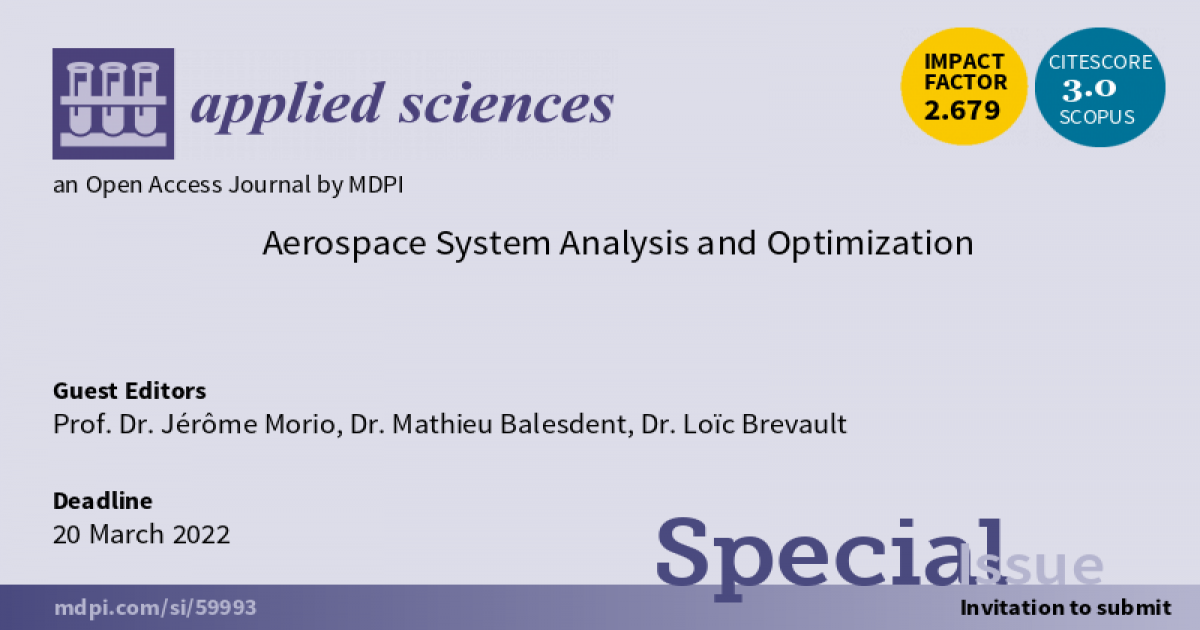Aerospace System Analysis and Optimization
A special issue of Applied Sciences (ISSN 2076-3417). This special issue belongs to the section "Aerospace Science and Engineering".
Deadline for manuscript submissions: closed (20 March 2022) | Viewed by 28830

Special Issue Editors
Interests: safety engineering; uncertainty management in complex aerospace systems (reliability, sensitivity analysis, surrogate modeling, etc.)
Special Issues, Collections and Topics in MDPI journals
Interests: the design of aerospace systems; multidisciplinary design optimization; uncertainty quantification; reliability-based design optimization
Special Issues, Collections and Topics in MDPI journals
Interests: multidisciplinary design optimization; uncertainty quantification; machine learning for the design of complex systems; mixed discrete/continuous optimization; aerospace vehicle design
Special Issues, Collections and Topics in MDPI journals
Special Issue Information
Dear Colleagues,
In today’s complex aerospace system engineering, designers face requirements that become a challenge to satisfy: System specifications are narrowing (due to safety regulations, environmental constraints, costs, etc.), development delays are shortening, and the performances of the system have to be established as soon as possible with sufficient accuracy. The design of aerospace systems is thus a complex and inherently multidisciplinary process involving several disciplines ranging from aerodynamics, propulsion, structures, electric/hydraulic systems, and guidance to navigation and control, each including different groups of highly experienced experts and advanced high-fidelity simulation models. This multidisciplinary process can be considered as the paradigm for general complex engineering systems in which experiments are replaced by large-scale expensive numerical simulations, enabling to reduce testing costs, to mitigate risks, and to shrink development duration.
A large range of mathematical algorithms blossom to face up to the challenges induced by aerospace system design and simulation. The scope of this Special Issue is to present the latest methodological and applied developments for aerospace system analysis and optimization. Fields for this SPECIAL ISSUE involve new advances in particular on aerospace system analysis, uncertainty quantification, aerospace system identification and modeling, machine learning for aerospace systems, multidisciplinary analysis, and optimization and multifidelity modeling.
Prof. Dr. Jérôme Morio
Dr. Mathieu Balesdent
Dr. Loïc Brevault
Guest Editors
Manuscript Submission Information
Manuscripts should be submitted online at www.mdpi.com by registering and logging in to this website. Once you are registered, click here to go to the submission form. Manuscripts can be submitted until the deadline. All submissions that pass pre-check are peer-reviewed. Accepted papers will be published continuously in the journal (as soon as accepted) and will be listed together on the special issue website. Research articles, review articles as well as short communications are invited. For planned papers, a title and short abstract (about 100 words) can be sent to the Editorial Office for announcement on this website.
Submitted manuscripts should not have been published previously, nor be under consideration for publication elsewhere (except conference proceedings papers). All manuscripts are thoroughly refereed through a single-blind peer-review process. A guide for authors and other relevant information for submission of manuscripts is available on the Instructions for Authors page. Applied Sciences is an international peer-reviewed open access semimonthly journal published by MDPI.
Please visit the Instructions for Authors page before submitting a manuscript. The Article Processing Charge (APC) for publication in this open access journal is 2400 CHF (Swiss Francs). Submitted papers should be well formatted and use good English. Authors may use MDPI's English editing service prior to publication or during author revisions.
Keywords
- aerospace system modeling and optimization
- multidisciplinary analysis and optimization
- multifidelity simulation
- uncertainty management
- data science
- reliability
- surrogate modeling
- machine learning for aerospace systems







